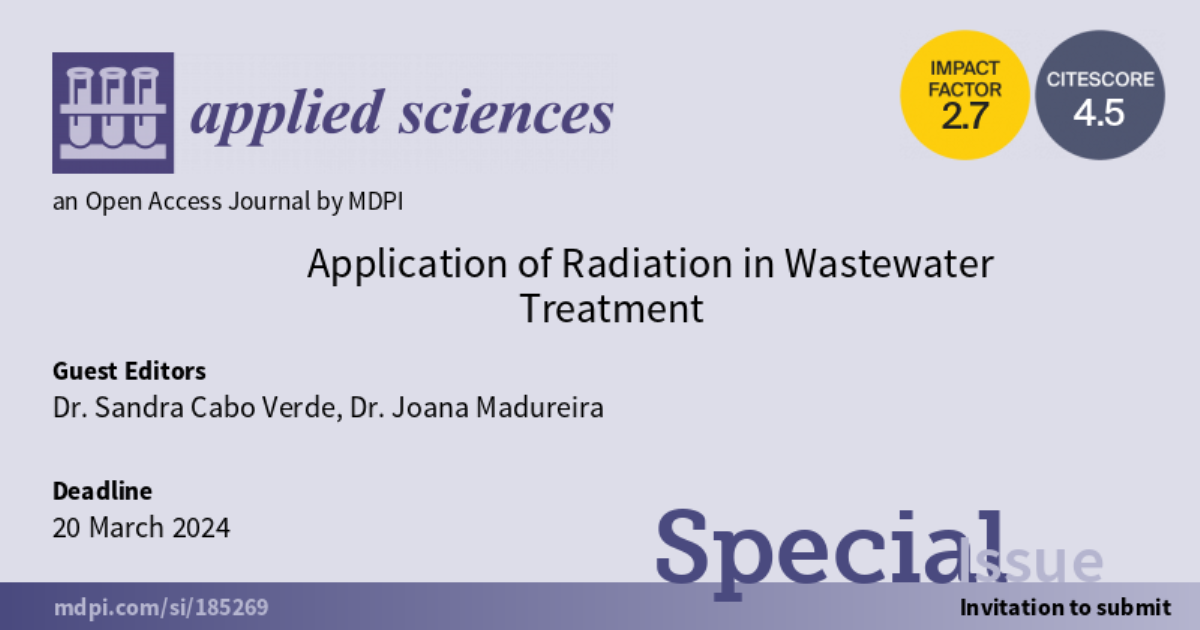Application of Radiation in Wastewater Treatment
A special issue of Applied Sciences (ISSN 2076-3417). This special issue belongs to the section "Environmental Sciences".
Deadline for manuscript submissions: closed (20 September 2024) | Viewed by 3854

Special Issue Editors
Interests: aromatic plants; antimicrobial properties; bioactivity; food safety and quality
Special Issues, Collections and Topics in MDPI journals
Interests: bioactive compounds; agro-industrial waste valorization; natural products; food preservation; radiation technologies
Special Issues, Collections and Topics in MDPI journals
Special Issue Information
Dear Colleagues,
Due to the proliferation of the human population, urbanization and industrialization, the problems associated with wastewater disposal have become an inevitable issue. The conventional wastewater treatment plants (WWTPs) seem to present inefficient processes in the treatment of contaminated wastewaters, making the development of emerging technologies, such as ionizing radiation, essential to overcoming this need. The application of this innovative technology could contribute to a reduction in the negative impact of these discharges on the environment.
This Special Issue aims to present recent advances in the research and applications of ionizing radiation in treating municipal and industrial wastewaters, alone or in combination with other processes. Among other topics, we welcome the submission of papers that address the optimized treatment conditions/methodologies employed for the degradation of pollutants and their reaction mechanisms, kinetic modelling, the inactivation of microorganisms, and toxicity assessment and economic evaluation, involving experimental and pilot-scale applications.
In this context, we welcome the submission of original, communication and review articles addressing the feasibility and sustainability of this technology.
Dr. Sandra Cabo Verde
Dr. Joana Madureira
Guest Editors
Manuscript Submission Information
Manuscripts should be submitted online at www.mdpi.com by registering and logging in to this website. Once you are registered, click here to go to the submission form. Manuscripts can be submitted until the deadline. All submissions that pass pre-check are peer-reviewed. Accepted papers will be published continuously in the journal (as soon as accepted) and will be listed together on the special issue website. Research articles, review articles as well as short communications are invited. For planned papers, a title and short abstract (about 250 words) can be sent to the Editorial Office for assessment.
Submitted manuscripts should not have been published previously, nor be under consideration for publication elsewhere (except conference proceedings papers). All manuscripts are thoroughly refereed through a single-blind peer-review process. A guide for authors and other relevant information for submission of manuscripts is available on the Instructions for Authors page. Applied Sciences is an international peer-reviewed open access semimonthly journal published by MDPI.
Please visit the Instructions for Authors page before submitting a manuscript. The Article Processing Charge (APC) for publication in this open access journal is 2400 CHF (Swiss Francs). Submitted papers should be well formatted and use good English. Authors may use MDPI's English editing service prior to publication or during author revisions.
Keywords
- wastewater treatment
- ionizing radiation
- wastewater management
- bioremediation
- water radiolysis
- radiolytic degradation
- inactivation of microorganisms
Benefits of Publishing in a Special Issue
- Ease of navigation: Grouping papers by topic helps scholars navigate broad scope journals more efficiently.
- Greater discoverability: Special Issues support the reach and impact of scientific research. Articles in Special Issues are more discoverable and cited more frequently.
- Expansion of research network: Special Issues facilitate connections among authors, fostering scientific collaborations.
- External promotion: Articles in Special Issues are often promoted through the journal's social media, increasing their visibility.
- Reprint: MDPI Books provides the opportunity to republish successful Special Issues in book format, both online and in print.
Further information on MDPI's Special Issue policies can be found here.






